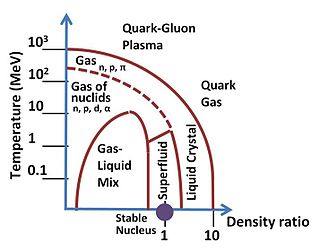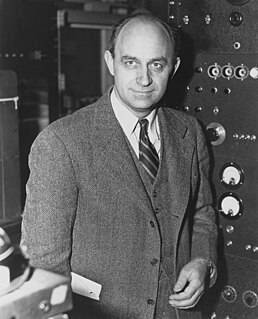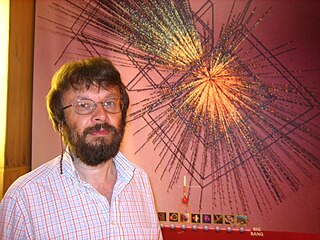| Nuclear physics |
|---|
 |
| Nucleus · Nucleons (p, n) · Nuclear matter · Nuclear force · Nuclear structure · Nuclear reaction |
Nuclear stability |
High energy processes |
Nuclear fusion Processes: Stellar · Big Bang · Supernova Nuclides: Primordial · Cosmogenic · Artificial |
Alvarez · Becquerel · Bethe · A.Bohr · N.Bohr · Chadwick · Cockcroft · Ir.Curie · Fr.Curie · Pi.Curie · Skłodowska-Curie · Davisson · Fermi · Hahn · Jensen · Lawrence · Mayer · Meitner · Oliphant · Oppenheimer · Proca · Purcell · Rabi · Rutherford · Soddy · Strassmann · Szilárd · Teller · Thomson · Walton · Wigner |
High-energy nuclear physics studies the behaviour of nuclear matter in energy regimes typical of high energy physics. The primary focus of this field is the study of heavy-ion collisions, as compared to lower atomic mass atoms in other particle accelerators. At sufficient collision energies, these types of collisions are theorized to produce the quark–gluon plasma. In peripheral nuclear collisions at high energies one expects to obtain information on the electromagnetic production of leptons and mesons which are not accessible in electron-positron colliders due to their much smaller luminosities. [1] [2] [3]

A quark–gluon plasma (QGP) or quark soup is a state of matter in quantum chromodynamics (QCD) which exists at extremely high temperature and/or density. This state is thought to consist of asymptotically free strong-interacting quarks and gluons, which are ordinarily confined by color confinement inside atomic nuclei or other hadrons. This is in analogy with the conventional plasma where nuclei and electrons, confined inside atoms by electrostatic forces at ambient conditions, can move freely. Artificial quark matter, which has been produced at Brookhaven National Laboratory's Relativistic Heavy Ion Collider and CERN's Large Hadron Collider, can only be produced in minute quantities and is unstable and impossible to contain, and will radioactively decay within a fraction of a second into stable particles through hadronization; the produced hadrons or their decay products and gamma rays can then be detected. In the quark matter phase diagram, QGP is placed in the high-temperature, high-density regime, whereas ordinary matter is a cold and rarefied mixture of nuclei and vacuum, and the hypothetical quark stars would consist of relatively cold, but dense quark matter. It is believed that up to a few milliseconds after the Big Bang, known as the quark epoch, the Universe was in a quark–gluon plasma state.
Contents
Previous high-energy nuclear accelerator experiments have studied heavy-ion collisions using projectile energies of 1 GeV/nucleon up to 158 GeV/nucleon. Experiments of this type, called "fixed target" experiments, primarily accelerate a "bunch" of ions (typically around to ions per bunch) to speeds approaching the speed of light (0.999c) and smash them into a target of similar heavy ions. While all collision systems are interesting, great focus was applied in the late 1990s to symmetric collision systems of gold beams on gold targets at Brookhaven National Laboratory's Alternating Gradient Synchrotron (AGS) and uranium beams on uranium targets at CERN's Super Proton Synchrotron.

A particle accelerator is a machine that uses electromagnetic fields to propel charged particles to very high speeds and energies, and to contain them in well-defined beams.

The speed of light in vacuum, commonly denoted c, is a universal physical constant important in many areas of physics. Its exact value is 299,792,458 metres per second. It is exact because by international agreement a metre is defined as the length of the path travelled by light in vacuum during a time interval of 1/299792458 second. According to special relativity, c is the maximum speed at which all conventional matter and hence all known forms of information in the universe can travel. Though this speed is most commonly associated with light, it is in fact the speed at which all massless particles and changes of the associated fields travel in vacuum. Such particles and waves travel at c regardless of the motion of the source or the inertial reference frame of the observer. In the special and general theories of relativity, c interrelates space and time, and also appears in the famous equation of mass–energy equivalence E = mc2.

Gold is a chemical element with symbol Au and atomic number 79, making it one of the higher atomic number elements that occur naturally. In its purest form, it is a bright, slightly reddish yellow, dense, soft, malleable, and ductile metal. Chemically, gold is a transition metal and a group 11 element. It is one of the least reactive chemical elements and is solid under standard conditions. Gold often occurs in free elemental (native) form, as nuggets or grains, in rocks, in veins, and in alluvial deposits. It occurs in a solid solution series with the native element silver and also naturally alloyed with copper and palladium. Less commonly, it occurs in minerals as gold compounds, often with tellurium.
Currently, high-energy nuclear physics experiments are being conducted at Brookhaven National Laboratory's Relativistic Heavy Ion Collider (RHIC) and in CERN's new Large Hadron Collider. The four primary experiments at RHIC (PHENIX, STAR, PHOBOS, and BRAHMS) study collisions of highly relativistic nuclei. Unlike fixed target experiments, collider experiments steer two accelerated beams of ions toward each other at (in the case of RHIC) six interaction regions. At RHIC, ions can be accelerated (depending on the ion size) from 100 GeV/nucleon to 250GeV/nucleon. Since each colliding ion possesses this energy moving in opposite directions, the maximum energy of the collisions can achieve a center of mass collision energy of 200GeV/nucleon for gold and 500GeV/nucleon for protons.

Brookhaven National Laboratory (BNL) is a United States Department of Energy national laboratory located in Upton, New York, on Long Island, and was formally established in 1947 at the site of Camp Upton, a former U.S. Army base. Its name stems from its location within the Town of Brookhaven, approximately 60 miles east of New York City.

The Relativistic Heavy Ion Collider is the first and one of only two operating heavy-ion colliders, and the only spin-polarized proton collider ever built. Located at Brookhaven National Laboratory (BNL) in Upton, New York, and used by an international team of researchers, it is the only operating particle collider in the US. By using RHIC to collide ions traveling at relativistic speeds, physicists study the primordial form of matter that existed in the universe shortly after the Big Bang. By colliding spin-polarized protons, the spin structure of the proton is explored.

The European Organization for Nuclear Research, known as CERN, is a European research organization that operates the largest particle physics laboratory in the world. Established in 1954, the organization is based in a northwest suburb of Geneva on the Franco–Swiss border and has 23 member states. Israel is the only non-European country granted full membership. CERN is an official United Nations Observer.
The ALICE (A Large Ion Collider Experiment) detector at the LHC at CERN is specialized in studying Pb-Pb nuclei collisions at a centre of mass energy of 2.76 TeV per nucleon pair. Other LHC detectors like CMS, ATLAS, and LHCb also have heavy ion programs.















